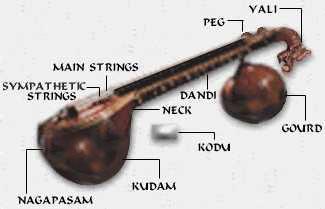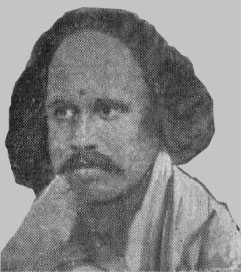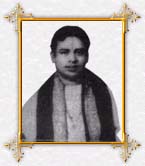Sangeetanubhava
MUSICAL EXPRESSIONS
In the coming weeks, Carnatica will bring you the papers presented by the participants at these Conferences.
STRING INSTRUMENTS - 1999
- By N Ravikiran
The Chitravina is one of the most beautiful musical instruments in the world today. Also referred to as Gotuvadyam, it is a twenty-one stringed fretless Indian lute. It has a hollow stem made of resonant wood, about thirty two inches long and four inches wide. It has a flat top and is set on two chambers; the main sound chamber is made out of wood and a secondary resonator is made of a gourd. It contains six melody strings and three secondary strings for maintaining drone. The remaining strings are sympathetic and run parallel to and below the melody strings.
A couple of plectrums on the fingers of the right hand are used to pluck the six main melody strings; a cylindrical block, made out of ebony, is glided over them with the left hand (I have replaced this with the smoother Teflon).

The smooth singing tone of Chitravina is probably its most unique feature. As the New York Times described, the Chitravina has '...infinite capacity for micro-tonal shadings reminiscent of the human voice' . This is not only because of its fretless nature but also because of its unique string arrangement. The Chitravina is a delicate, beautiful instrument , which in the hands of a master, can express all the nuances of Carnatic vocal and instrumental music. In recent times, it has proved its versatility as a major world instrument in fusion crossover concerts too.
The Chitravina, probably one of the oldest instruments in the world, is comparatively rare, but its popularity is steadily increasing. The major credit for its respectable stature should be given to stalwarts like Tiruvadaimarudur Sakha Rama Rao , Gotuvadyam Narayana Iyengar, Budalur Krishnamoorti Sastri, Gotuvadyam Narasimhan etc. By Gods grace , I have had the honour and good fortune to share the beauty and greatness of his instrument with people all over the world.
EARLY HISTORY
The earliest reference to Chitravina is in Bharata's Natya Sastra , more than 3000 years
ago. It was referred to as a seven stringed instrument played with fingers and a
cylindrical device (kona) . The Natya Sastra also refers to a similar instrument with 9
strings, Vipanchi Vina.
The next main treatise, Sangeeta Ratnakara by Sarangadeva, written a few centuries later
also refers to both instruments in exactly the same manner , suggesting that there
was no real change in between.
The Chitravina might have, since then, undergone many modifications but very little of it
has been documented clearly. In all probability, the instrument really was pretty
dormant as fretted instruments held sway for many centuries. The reasons for this are not
difficult to fathom.
The advantage of an instrument with frets is that the margin of error is considerably
reduced as the notes are fixed by means of the frets and the artiste can place
fingers almost anywhere between two frets and get the right note. Thus, an artiste playing an
instrument like the Vina, Sitar and Guitar has at least a few centimetres to an inch
and
more to play the note correctly.
On the other hand, an artiste playing fretless instruments, especially with a slide like
Chitravina,
Vichitravina and Slide Guitars like the Mohan Vina has got to be precise by
micrometers in order to hit the right note. Even the minutest deviation from the only
place will lead to a false note, which can be disastrous. Thus, a fretless instrument
is
infinitely more challenging than an instrument with frets.
So man gradually developed various fretted instruments and since these possessed obvious
advantages over fretless ones, the Chitravina may have died a natural death.
RE-EMERGENCE
Until Srinivasa Rao came along, about 150 years back, the Chitravina was out of
vogue. Srinivasa Rao was an ardent music lover and an
amateur artiste himself and he started experimenting with a slide on the Tanpura. He loved what he heard and got pretty serious about it. It was his habit to play
almost every afternoon with this and his son Sakha Rama Rao was drawn to this
since his childhood. He saw the tremendous potential this type of instrument had and
decided to give it a better shape, design and stature.

Tiruvidaimarudur Sakha Rama Rao
With his high intelligence, analytical approach and hardwork, he was able to re-design this instrument like the 24-fretted Vina, with 7 strings. Thus, from a distance, his instrument looked like a Vina without frets. It had 4 strings on the top and 3 in the side for drone and rhythm.
He practised regularly for hours on end and started performing on this occasionally, delighting music lovers wherever he went. Since he was not aware of the history of the instrument, he gave it a new name - Gotuvadyam. He casually referred to the slide as Gotu and vadyam (in Sanskrit and many other languages) means instrument. Thus Gotuvadyam was a very clear and scientific name for an instrument played with a slide , according to Sakha Rama Rao. (Many years later , I went into the origins of this instrument and restored the original name.)
Sakha Rama Rao was a musicians' musician and trained many a great artiste like Gotuvadyam Narayana Iyengar (my grandfather) and Semmangudi Srinivasa Iyer. Soon there were many others who started to play Gotuvadyam at various levels.
The next path blazer in this instrument was Narayana Iyengar who was a born genius. His innovations in this instrument were responsible for taking it tremendous heights and most of those innovations have come to stay. He changed the string arrangements almost totally, giving it a unique tonal depth, hitherto never heard before. A performer of the highest order and tremendous popularity , he still found time and energy to constantly refine and improve this instrument all through his life.
He experimented ceaselessly and added 3 more strings to the 4 main strings and also brought in 12 resonance strings in a special layer below the main strings. Now the instrument had 22 strings (which has since become 21 as one of the 7 main strings have been discarded later on by Chitravina Narasimhan , another great musician and son of Narayana Iyengar).

Gotuvadyam Narayana Iyengar
His resonance strings are again very unique . He arranged them in such a way as to give a
built in Tanpura effect. Also the use of the jivalam (a small thread on the
bridge which contributes to a qualitative and quantitative enhancement of the tone)
for
each of the 12 resonance strings made it vibrate much more steadily when music was
played on top. This in turn added to the overall richness of the tone of the
Chitravina.
Narayana Iyengar also designed the instrument very efficiently with a fine tuning
provision for each of the 21/22 strings . The Chitravina is one of the very few
instruments in the world (with more than 20 strings) and probably the only one in India,
which has such fine tuning provision for each of its 21 strings.
Narayana Iyengar also standardized the pitch , the types of strings and many other
things on the instrument.
His innovations and overall contribution to the growth of Chitravina is unparalleled.
Chitravina Narasimhan
Son and disciple of Narayana Iyengar, Narasimhan continued on the lines of his
father but also bought in his own mind when it came to modification of string arrangements, the length of the slide and other such minute details. His other great
contribution was to spread the name and fame of instrument among many other fellow
musicians.
I was so fascinated with the instrument from the earliest times I can remember . I took to this instrument seriously
from the age of 4 or 5 and endeavored to play everything that my father Chitravina
Narasimhan taught me to sing. He also saw my interest in Chitravina and taught me many
instrumental techniques too. This combination of vocal and instrumental styles
have enabled me to evolve a bani of my own.
I was interested in improving the tonal quality and purity of the instrument by using some
other medium for the slide. I had been trying different materials including
steel and glass and was none too happy with the results. In 1989, a music-lover in
USA, Mr. Varadarajan , suggested Teflon as probably the smoothest material known
to man. He in fact , went further and actually got me a sample piece of it and I have used
it effectively in my Chitravina since 1989. Its almost frictionless surface brings
out a
very pure tone eliminating string slide noises which are heard when slides made of ebony,
steel, stone or bison horn are used.
In fact, some western slide guitarists have been so impressed with Teflon they too have
started using it in place of their usual steel or plastic slides.
My firm belief that the Chitravina can 'sing' has been justified, and today the Chitravina is acknowledged as one of the most
versatile and appealing instruments.
Other stalwarts of this instrument include Sangeeta Kalanidhi Budalur
Krishnamoorti Sastri , Mannargudi Savitri Ammal, A Narayana Iyer, M V Varahaswami, Gayatri
Kassabaum
and Allam Koteeswara Rao.
Of these, Budalur Krishnamoorti Shastri, an outstanding vocalist as well, was
steadfast in sticking to the tuning and string arrangement of the Vina save for an
extra string he added at the top, but only to rest his fingers on. He was not keen on the
sympathetic resonance strings at all and many of his disciples still follow his
pattern.
There is a school of thought in the USA that it was the Chitravina that inspired the
Hawaiians to play the guitar with a 'slide' (which in turn probably influenced the
Blues singers in the Mississippi delta later on ). Appropriately, this possible
transmigration came a full circle in some of my recent collaborations with
well-known
international Blues singers and Hawaiians guitarists!
The demand for Chitravina has grown tremendously among music lovers and students. With the
emergence of promising youngsters like Chitravina Ganesh, the
future of Chitravina looks immensely bright.